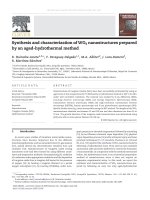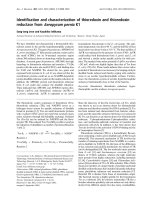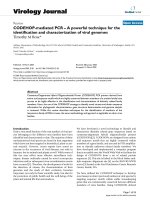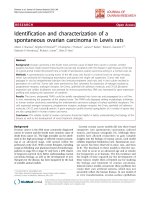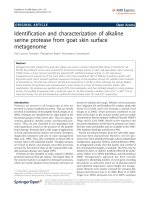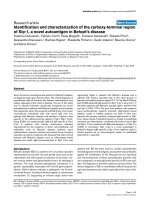Identification and characterization of conserved regulatory elements by comparative genomics
Bạn đang xem bản rút gọn của tài liệu. Xem và tải ngay bản đầy đủ của tài liệu tại đây (1.89 MB, 173 trang )
IDENTIFICATION AND CHARACTERIZATION OF
CONSERVED REGULATORY ELEMENTS
BY COMPARATIVE GENOMICS
KRISH JON MATHAVAN
(B.Sc. (Hons.) University of New South Wales)
A THESIS SUBMITTED FOR THE
DEGREE OF DOCTOR OF PHILISOPHY
INSTITUTE OF MOLECULAR AND CELL BIOLOGY
NATIONAL UNIVERSITY OF SINGAPORE
2008
ii
Acknowledgements
I would like to thank firstly my supervisor Byrappa Venkatesh, especially for the patience
and support shown to me during the writing of this thesis.
I would also like to thank the past and present members of the SB and FUGE lab for the
friendship and help with techniques and reagents, especially Tay Boon Hui, Sumanti
Tohari, Elizabeth Yeoh and Diane Tan.
I would also like to thank Jian Liang from Walter’s lab; and Guo Ke, Li Jie and Bin Qi
from the histology lab who taught me histology and provided much expertise in helping
me fine-tune the various techniques involved, and who went out of their way to help
whenever possible. I would also like to thank Arun from BRC who helped to make the
transgenic work run more smoothly for me.
I would like to thank members of my supervisory committee: Walter Hunziker and Wang
Yue for the feedback given during the development of this project.
Finally I would like to thank my loved one and friends both here and in Australia, who
have been supporting me during the whole doctorate, and who have kept me strong when
I was disheartened and who encouraged me through the thesis.
iii
TABLE OF CONTENTS
Acknowledgements……………………………………………………………… ii
Table of Contents…………………………………………………………………… …iii
Summary…………………………………………………………………………vii
List of Tables…………………………………………………………………… ix
List of Figures…………………………………………………………………… x
List of Abbreviations…………………………………………………………….xii
Chapter 1 Introduction………………………………………………………………….1
1.1 Functional sequences in the human genome………………………………… 2
1.2 Cis-regulatory elements……………………………………………………….3
1.3 Cis-regulatory elements and genetic diseases…………………………………5
1.4 Identification of cis-regulatory elements…………………………………… 7
1.4.1 Traditional methods……………………………………… …… 8
1.4.2 High throughput methods……………………………………… 10
1.5 Using comparative genomics to identify cis-regulatory elements………… 12
1.5.1 Comparison of closely related species…………… …………….13
1.5.2 Extreme conservation within mammals………………………….16
1.5.3 Comparison of distantly related vertebrates…………………… 18
1.5.4 Alignment and visualization tools for comparative genomics… 24
1.6 Objectives of the present study………………………………………………27
Chapter 2 Materials and methods………………………………………………… 32
iv
2.1 Genomic sequence alignment and prediction of conserved noncoding
sequences……………………………………………………………………… 33
2.2 Generation of DNA constructs for microinjection………………………… 35
2.3 Isolation and sequencing of fugu cosmid to map the orexin locus………… 36
2.4 Generation of transgenic mice……………………………………………….37
2.5 Preparation of DNA for microinjection…………………………………… 38
2.6 Genotyping………………………………………………………………… 39
2.7 In situ hybridization………………………………………………………….41
2.7.1 Preparation of embryos and tissues for whole-mount or section in
situ hybridization……………………………………………………… 41
2.7.2 Synthesis of RNA probes for in situ hybridization……………… 43
2.7.3 Pretreatment of embryos and sections…………………………… 44
2.7.4 Hybridization, washing and antibody addition…………………….46
2.7.5 Visualization……………………………………………………….47
2.7.6 Double in situ hybridization……………………………………… 49
Chapter 3 Results: Identification of CNEs in forebrain genes………………………50
3.1 Introduction………………………………………………………………… 51
3.2 Identification of human, mouse and fugu forebrain genes………………… 52
3.3 Prediction of CNEs………………………………………………………… 52
3.4 Summary…………………………………………………………………… 58
Chapter 4 Results: Regulation of Six3……………………………………………… 60
4.1 Introduction………………………………………………………………… 61
4.2 Six3 loci in human, mouse and fugu; and identification of CNEs………… 62
v
4.3 Expression pattern of mouse Six3……………………………………………67
4.4 Functional assay of Six3 CNEs………………………………………………70
4.4.1 Basal promoter region (includes CNE13) of mouse Six3 is sufficient
to recapitulate most aspects of expression in the forebrain and eye during
early and late stages of development…….………………………………70
4.4.2 Expression patterns directed by CNE1, CNE2/3/4 and CNE5/6/7 74
4.4.3 Expression patterns directed by CNE8/9 and CNE12…… ………76
4.4.4 CNE10/11 silences the mouse Six3 promoter at all developmental
stages….…………… ………………………………………………… 81
4.4.5 Expression pattern directed by CNE14…… …………………… 81
4.4.6 Summary of the regulatory potential of mouse Six3 CNEs……… 82
4.5 Discussion……………………………………………………………………83
4.5.1 Comparison of results from Six3 regulation in medaka ……………86
Chapter 5 Results: Regulation of Foxb1………………………………………………90
5.1 Introduction………………………………………………………………… 91
5.2 Comparison of Foxb1 loci in human, mouse and fugu………………………92
5.3 Expression pattern of mouse Foxb1………………………………………….96
5.4 Functional assay of Foxb1 CNEs…………………………………………….99
5.4.1 Basal promoter region (includes CNE3) of mouse Foxb1 is sufficient
to recapitulate most aspects of endogenous expression during early and
late stages of development……………………………………………….99
5.4.2 Expression patterns directed by CNEs 1, 2, 4 and 5…………… 102
5.4.3 Summary of the regulatory potential of mouse Foxb1 CNEs…….107
vi
5.4.4 Conservation of regulation of Foxb1 between fugu and mouse….108
5.5 Discussion………………………………………………………………… 111
Chapter 6 Results: Regulation of Orexin …………………………………… …….118
6.1 Introduction…………………………………………………………………119
6.2 Comparison of ORX loci in human, mouse and fugu………………………121
6.3 Expression of fugu ORX in mouse…………………………………………123
6.4 Comparative analyses and validation of ORX regulatory elements common in
human, mouse and fugu……………………………………………………… 127
6.5 Discussion………………………………………………………………… 133
Chapter 7 General Discussion 138
7.1 Summary……………………………………………………………………139
7.2 High-success rate in identifying functional cis-regulatory elements……….140
7.3 Cooperativity and redundancy in cis-regulatory elements………………….142
7.4 Conserved function of cis-regulatory elements in mammals and fish without
apparent sequence conservation……………………………………………… 143
References…………………………………………………………………………… 146
Annex I………………………………………………………………………………….159
vii
Summary
Comparative genomics is a powerful approach for identifying cis-regulatory elements in
the human genome. Noncoding sequences that exhibit high level of conservation between
genomes are likely to be under purifying selection and represent functional elements such
as cis-regulatory elements. The pufferfish (fugu) is a particularly attractive model for
discovering cis-regulatory elements in the human genome because of its compact intronic
and intergenic regions, and its maximal evolutionary distance (~420 million years) from
human. The aim of this study is to use fugu to predict conserved noncoding elements
(CNEs) in genes expressing in the human forebrain, and to characterize selected CNEs in
transgenic mice to identify cis-regulatory elements that direct tissue-specific expression
in developing embryos. To this end, genomic sequences for 50 human genes that express
in the forebrain were aligned with their orthologous sequences in mouse and fugu using a
global algorithm program (MLAGAN) and CNEs were predicted using the criteria of at
least 60% identity over 50 bp. Altogether 206 CNEs (total length ~30 kb) associated with
29 genes were identified. CNEs associated with two transcription factor genes, Six3 and
Foxb1, were assayed in transgenic mice using a lacZ reporter gene. All the CNEs assayed
were found to function as cis-regulatory elements by either enhancing or suppressing
expression of the reporter gene in a tissue- and developmental-stage specific manner.
Interestingly, the highly conserved basal promoter regions of Six3 and Foxb1 genes were
found to contain regulatory elements required for expression in almost all the domains in
early and late stages of development, while the CNEs dispersed in the intergenic regions
were found to ‘fine-tune’ the expression driven by the basal promoter by enhancing or
silencing expression in particular domains. Many CNEs were found to have overlapping
viii
expression patterns reflecting the redundancy built into the regulatory code for ensuring
the correct spatial and temporal expression patterns of genes. These results demonstrate
that comparative genomics using fugu is a useful approach for identifying evolutionarily
conserved cis-regulatory elements in the human genome.
I also analyzed the regulatory region of orexin (ORX) gene which did not contain CNEs,
in order to understand the molecular basis of cell-specific expression of such genes.
Despite the absence of CNEs, the fugu ORX regulatory region was able to direct neuron-
specific expression in the hypothalamus of transgenic mice. Close inspection of
sequences revealed cis-regulatory elements with sequence identities below the threshold
level of CNEs. These vertebrate genes appear to be associated with two types of
enhancers: one that is highly constrained in structure and organization and detected by a
high level of sequence conservation in distant vertebrates; and another one that is weakly
constrained and flexible in its organization and requires comparison with closely and
distantly related species and identification by conservation at the level of transcription
factor-binding sites. Thus, alternative strategies are required for the identification of all
the cis-regulatory elements in the human genome.
ix
List of Tables
1: List of 50 forebrain genes with the number and total length of CNEs associated with
each gene…………………………………………………………………………………55
2: Number of CNEs identified and the functional categories of genes………………… 58
3: Six3 CNEs tested in transgenic mice………………………………………………….65
4: Enhancer function of mouse Six3 CNEs across different developmental stages and in
different tissues………………………………………………………………………… 83
5: Foxb1 CNEs tested in transgenic mice……………………………………………… 96
6: Enhancer function of mouse Foxb1 CNEs across different developmental stages and in
different tissues…………………………………………………………………………108
x
List of Figures
1: Schematic diagram of the developing forebrain………………………………………29
2: Identification of CNEs in Otp locus in human, mouse and fugu…………………… 54
3: Six3 loci of human, mouse and fugu………………………………………………… 63
4: Conserved noncoding elements in the Six3 locus…………………………………… 65
5: Expression patterns of Six3 in the developing mouse embryo……………………… 68
6: A 860-bp promoter region of mouse Six3 directs expression of lacZ mRNA to the
forebrain and eye during embryonic development………………………………………71
7: Expression patterns directed by CNE1, CNE2/3/4 and CNE5/6/7……………………75
8: Expression patterns directed by CNE8/9 and CNE12……………………………… 78
9: Expression pattern directed by CNE14 at E9.5-E11.5……………………………… 82
10: Summary of the regulatory code that controls the expression of Six3 in mouse…….89
11: Foxb1 loci of human, mouse and fugu………………………………………………93
12: Conserved noncoding elements in the Foxb1 locus………………………………….95
13: CNEs selected for testing in transgenic mice……………………………………… 95
14: Expression patterns of Foxb1 in the developing mouse embryo…………………….98
15: A 400-bp basal promoter region of mouse Foxb1 directs expression of lacZ mRNA to
the diencephalon, midbrain and hindbrain during embryonic development……………100
16: Whole mount in situ hybridization showing expression patterns directed by Foxb1
CNE1, CNE2, CNE4 and CNE5……………………………………………………… 104
17: A fugu construct containing CNEs 1, 2, 4 and 5 upstream of the basal promoter
containing CNE3 reproduces mouse endogenous Foxb1 expression in the diencephalon,
midbrain and hindbrain…………………………………………………………………110
18: Summary of the regulatory code that controls the expression of Foxb1 in mouse…116
19: ORX locus in fugu, mouse and human…………………………………………… 122
xi
20: Expression of fugu ORX gene in transgenic mice compared with the expression of the
endogenous mouse ORX expression……………………………………………………125
21: Poorly conserved mouse and human regulatory elements in the fugu ORX locus…129
22: Analysis of the regulatory region of fugu ORX in transgenic mice……………… 131
23: Expression of fugu ORX in transgenic mice compared with the expression of the
endogenous mouse ORX……………………………………………………………… 132
xii
List of Abbreviations
bp base pair
CTP cytosine triphosphate
DNase deoxyribonuclease
DEPC diethyl pyrocarbonate
EDTA ethylenediamine-N,N,N’,N’-tetraacetic acid
HCl hydrochloric acid
kb kilobase
LHA lateral hypothalamus
MYA million years ago
NaCl sodium chloride
NaOAc sodium acetate
NaOH sodium hydroxide
PBS phosphate buffered saline
PCR polymerase chain reaction
RT room temperature
SDS sodium dodecyl sulfate
tRNA transfer RNA
TE tris and EDTA
TFBS transcription factor binding sites
UTR untranslated region (of an mRNA)
1
Chapter 1
Introduction
2
1.1 Functional sequences in the human genome
The Human Genome Project is the largest project ever attempted in biological sciences.
Its main objectives are to determine the complete sequence of the human genome, and to
identify and characterize all functional elements which would lead to a more complete
understanding of the structure, function and evolutionary history of the human genome.
The first objective was largely accomplished in 2001 when two “draft” sequences were
generated (Lander et al., 2001; Venter et al., 2001). Most of the gaps in these draft
sequences have since been filled-up and now the human genome sequence is essentially
complete (International Human Genome Sequencing Consortium, 2004). However,
although about 21,000 protein coding genes comprising about 1.5% of the human
genome have been predicted, we are still far from identifying all functional elements.
Since we have a good understanding of the genetic code and structure of protein coding
genes, on hindsight, predicting protein-coding sequences was the easiest part of the
annotation. Identifying and characterizing the “other” functional elements in the human
genome which do not have a well-defined structure like the protein-coding genes, has
become a major challenge in this post-human genome sequencing era.
How much of the 3000-Mb human genome sequence is functional? This is a highly
debated issue with estimates ranging from 3% to 70% depending on the method used for
identifying functional elements (Pheasant and Mattick, 2007; Waterston et al., 2002). A
typical method for identifying functional sequences is by comparing the human genome
sequence with related genomes and estimating the portion of the genome that is evolving
more slowly than the neutrally evolving sequences. The slowly evolving sequences that
3
are under selective constraint are likely to be functional elements in these genomes. A
systematic comparison of the whole genome sequences of the human and mouse genomes
has indicated that about 5% of these genomes are under selective constraint since they
diverged from a common ancestor. This implies that at least 5% of the human and mouse
genomes comprise functional sequences (Waterston et al., 2002). Since the protein-
coding sequences account for 1.5% of these genomes, this analysis indicates that
noncoding functional elements are three-fold higher than protein-coding sequences, and
underscores the challenge in identifying and characterizing these functional elements.
The non-coding functional sequences in the human genome include RNA genes such as
transfer RNA (tRNA), ribosomal RNA (rRNA), and small RNAs like small interfering
RNA (siRNA) and micro RNA (miRNA); transcriptional regulatory elements; splicing
regulatory elements; sequences conferring structural chromatin features; and sequences
playing a role in chromosomal replication and recombination. The main objective of my
work is to identify and characterize transcriptional regulatory elements (referred to as
“cis-regulatory elements” or “enhancers” in this thesis) in the human genome.
1.2 Cis-regulatory elements
Cis-regulatory elements are DNA sequences that mediate spatial and temporal expression
patterns of genes. Transcription factors bind to cis-regulatory elements and activate or
repress transcription of target genes associated with the cis-regulatory element in a cell-
type or tissue-specific manner at specific developmental stages. Cis-regulatory elements
comprise binding sites for transcription factors that are often organized into clusters
called cis-regulatory modules (CRMs) or enhancers. The CRMs typically span a few
4
hundred nucleotides, and can contain dozens of binding sites for ~3-10 transcription
factors that activate or repress gene transcription (Chen and Rajewsky, 2007). Complex
gene expression patterns frequently evolve from an orchestrated activity of several
different cis-regulatory modules with distinct spatiotemporal activity patterns. For
instance, in the Drosophila embryos the even-skipped (eve) gene, a pair-rule gene, is
transcribed in alternate embryonic parasegments to generate a zebra pattern of seven
stripes. The transcriptional state of this gene - either ON or OFF depending on which
parasegment - is under the control of a series of CRMs, with about one module
responsible for expression in each stripe (Sackerson et al., 1999).
Cis-regulatory elements also confer regulatory control in the timing of gene expression.
For example, there is emerging evidence that the precise temporal expression of Hox
genes is crucial for the establishment of regional identities. Deletion of the Hoxd11
enhancer in mice delays expression of both Hoxd10 and Hoxd11 during somitogenesis,
but at a later stage, normal expression of both genes is restored (Zakany et al., 1997).
However this regulatory deletion could not prevent the occurrence of defects in
patterning and specification of the vertebral column, although these were of less severity
than the complete Hoxd11 gene knockout (Zakany et al., 1997). Another similar study
showed that the deletion of an early enhancer of Hoxc8 resulted in a significant delay in
the temporal expression but did not eliminate the expression of the Hoxc8 protein. It
delayed the attainment of control levels of expression and anterior and posterior
boundaries of expression on the anterior-posterior axis and this temporal delay in Hoxc8
expression was sufficient to produce phenocopies of many of the axial skeletal defects
5
associated with the complete absence of the Hoxc8 gene product (Juan and Ruddle,
2003).
Cis-regulatory elements can reside close to the basal promoter, in introns, or in the 5’ and
3’-flanking sequences of their target genes. In some vertebrate genes, cis-regulatory
elements termed ‘long-range enhancers’, are located at several hundred kilobases away
from the target gene (Bagheri-Fam et al., 2006; de la Calle-Mustienes et al., 2005;
Kimura-Yoshida et al., 2004; Nobrega et al., 2003). In some instances, the long-range
enhancers are embedded in the introns of the neighbouring genes. For example the limb
enhancer of Sonic Hedgehog (SHH) gene has been found in the 5th intron of the
neighbouring limb region 1 homolog (LMBR1) gene that is 1Mb upstream (Lettice et al.,
2003); and the retina enhancer of the paired box gene 6 (Pax6) gene was found located in
the intron of the neighbouring elongation protein 4 homolog (ELP4) gene that is located
200 kb downstream (Kleinjan et al., 2001). Thus, cis-regulatory elements can be
potentially located within the introns or anywhere in the flanking regions of their target
genes.
1.3 Cis-regulatory elements and genetic diseases
Cis-regulatory elements have emerged as primary candidates that are likely to harbour
mutations contributing to human disease phenotypes. Although disease-associated
genetic changes commonly affect gene coding regions, some may exert their effect
through abnormal gene expression that results from mutations in cis-regulatory elements
that affect their interaction with the promoter and/or disrupt the chromatin structure of the
6
locus (Kleinjan and van Heyningen, 2005). The most obvious cases of transcriptional
misregulation as the cause of genetic disease are associated with visible chromosomal
rearrangements. For example, aniridia (absence of iris) and related eye anomalies are
caused mainly by haploinsufficiency of the paired box / homeodomain gene Pax6 at
human chromosome 11p13 (van Heyningen and Williamson, 2002). A number of aniridia
human subjects have been described with no identifiable mutation in the transcription
unit. Instead chromosomal rearrangements that disrupt the region downstream of the
Pax6 transcription unit have been implicated. Detailed mapping of the breakpoints placed
them about 125 kb beyond the final exon. Analysis of the region beyond this breakpoint
revealed the presence of a downstream regulatory region (DRR) located about 200 kb
away and within the intron of the adjacent ubiquitously expressed ELP4 gene (Kleinjan et
al., 2001). Deletion of this DRR showed that it is absolutely essential for expression of
Pax6 in the retina and iris, even in the presence of more proximal known retinal
enhancers, and explains why the aniridia phenotype in ‘position effect’ patients is
indistinguishable from aniridia in patients carrying coding region mutations in Pax6
(Kleinjan et al., 2006).
On the other hand, the phenotype caused by a regulatory mutation can be very different
from that caused by a coding region mutation, because such mutations may only be
affecting a subset of expressing tissues. The involvement of SHH in preaxial polydactyl
(the formation of additional anterior digits in the vertebrate limb) fits such a scenario,
because while SHH functions in brain and neural development, it also plays a key role in
defining the limb anterior-posterior axis (Kleinjan and van Heyningen, 2005). Normally
7
SHH is transiently expressed in the posterior part of the mouse limb and sets up a
morphogen gradient from this zone of polarizing activity to instruct cells with respect to
their antero-posterior fates and to specify digit identities. The limb-specific long-distance
enhancer of SHH is located at the extreme distance of 1 Mb from the gene it regulates,
residing in the intron of a neighbouring gene Lmbr1, and genetic lesions affecting this
element is responsible for the ectopic expression of SHH in the limb bud, resulting in
preaxial polydactyl in humans (Lettice et al., 2002). These instances of genetic diseases
highlight the need for a comprehensive cataloging and characterization of cis-regulatory
elements in the human genome, which should facilitate the identification and validation
of functionally significant variants and pathological mutations in the regulatory regions
of the genome.
1.4 Identification of cis-regulatory elements
Given that cis-regulatory elements comprise clusters of transcription factor binding sites
and such sites are typically short (6 to 10 bp long) and allow degeneracy in their
sequences, identifying functional cis-regulatory elements in the vast non-coding regions
of the human genome is a non-trivial exercise. Although individual transcription factor
binding sites can be predicted in silico based on similarity to experimentally validated
binding sites, such predictions are likely to contain a large number of false positives.
Following are some of the techniques used for identifying and validating cis-regulatory
elements.
8
1.4.1 Traditional methods
Traditional methods of identifying cis-regulatory elements can be categorized into
biochemical and genetic methods. Biochemical methods typically make use of the way
DNA is packaged in the cell. Histone proteins act like molecular spools that coil the
strands of DNA into bead-like units called nucleosomes, which help to organize the
higher levels of chromatin structure. Genes in these tightly condensed regions are not as
accessible for gene expression as compared to genes that have been unwound from their
nucleosome structure. As such, DNA that is ‘unpacked’ would often be hypersensitive to
endonucleases such as DNase I, and DNase I hypersensitive sites are good indicators of
the presence of enhancers. To identify DNase I hypersensitive sites, nuclei are prepared
from cells or a tissue and incubated with various concentrations of DNase I, and the DNA
is then extracted and digested with a restriction enzyme to make a defined end from
which the hypersensitive sites can be located. Early observations suggest that
hypersensitivity is associated with the removal of nucleosomes but more recent analyses
detect the presence of histones in modified form such as acetylation of histone H3 on
lysines 9 and 14 that reduce the affinity of the DNA for the nucleosome (Bernstein et al.,
2005). This in turn would facilitate the interaction of DNA with trans-acting factors, and
this property is made use of in DNase I footprinting where bound transcription factors
will tend to protect the ‘unpacked’ enhancer DNA from DNase I and produce a
characteristic ‘footprint’ when fractionated on a gel. However this method requires prior
knowledge of the transcription factors that bind the enhancer. Gel shift assays, known as
electrophoretic mobility shift assays (EMSA) can also be used to show that a known
transcription factor binds to a site in the cis-regulatory element. The labeled DNA in the
9
form of an oligo is incubated with nuclear extract containing the transcription factor, and
the mix is fractionated on an acrylamide gel. The transcription factor will retard the DNA
to which it is bound as compared to the unbound DNA, and the ‘shifted’ band can be
recognized easily on the gel. This method also requires prior knowledge of the
transcription factor, nuclear extract from the cell types in which the gene is expressed
(could be a problem if genes express in a small population of cells) and may involve a
large number of oligos if the candidate cis-regulatory regions span a large distance.
Candidate cis-regulatory elements can be validated for their transcription activating
potential using genetic assays that provide the appropriate array of transcription factors
and conditions in which they can bind. The best assay system is an in vivo whole
organism but tissue explants may be used when more rapid alternatives are needed.
Assays in cell lines offer an attractive rapid system, if appropriate cell lines that show
specific expression of genes of interest are available. Whole animal in vivo assay,
however, provides the best means of assessing functional elements in a biologically
relevant and tissue-specific context, and is the method of choice if the gene of interest is
developmentally regulated. The region of the candidate cis-regulatory element is cloned
upstream of a reporter gene and introduced into the system, and the expression of the
reporter mRNA or protein is measured in specific cells or tissues and in response to
regulatory signals. To locate the exact position of the cis-regulatory element, progressive
deletions are carried out until the minimal region required for activity is identified. These
experiments, however, are tedious, time consuming and expensive particularly if the
candidate cis-regulatory regions are large as in the case of human genes.
10
1.4.2 High-throughput methods
The human genome sequencing era heralded the development of high-throughput
methods to discover functional elements on a genome-wide scale. These methods can be
classified into biochemical methods and computational methods. One recently developed
biochemical method involves the use of DNase I hypersensitivity to measure the
appearance and disappearance of functional sites on a genome-wide scale by comparing
between cells of different tissues or comparing within the same type of cell in response to
changes in the cellular environment. This method has taken form in two recently
developed techniques known as quantitative chromatin profiling (Dorschner et al., 2004)
and massively parallel signature sequencing (Crawford et al., 2006). At present these
high throughput methods are limited in scope by the number of cell lines or tissue types
available, and can produce many false positives caused by non-specific digestion of
DNase at non-hypersensitive sites (Crawford et al., 2004).
Another increasingly popular method is the chromatin immunoprecipitation (ChIP) assay,
which is a modification of the ‘pull down’ assays in which target proteins are precipitated
from solution using an antibody coupled to a retrievable tag. ChIP assays capture in vivo
protein-DNA interactions by cross-linking proteins to their DNA recognition sites using
formaldehyde, fragmenting the protein-bound DNA, probing this DNA with a
transcription factor-specific antibody and then reversing the cross-linking to release the
bound DNA for subsequent detection by PCR amplification. Caveats to using the ChIP
assay include recovering indirect interactions caused by protein-protein contact rather
11
than protein-DNA interactions and the inability to detect precise contacts of binding
within the 500 bp region (average fragment size after shearing the chromatin) of the DNA
probe (Elnitski et al., 2006). High-throughput variations of the ChIP technique use
ligation-mediated PCR to amplify the pool of DNA sequences as uniformly as possible,
generating many copies of all genomic binding sites for a given protein. The assortment
of enhancers containing these binding sites recovered in a ChIP assay can then be
visualized by hybridization to a microarray of genomic sequences (Elnitski et al., 2006).
This approach called ChIP-chip has been used recently to interrogate protein-DNA
interactions in intact cells and in a genome-wide fashion (Kim et al., 2005).
Unfortunately ChIP-chip results are dependent on the availability of suitable microarrays
with high coverage and resolution, and on the affinity and specificity of the antibodies
used to recognize and bind the native protein of interest (Hudson and Snyder, 2006). In
addition, there is the possibility of background DNA being ‘pulled down’ by nonspecific
interactions of protein and DNA, leading to false positives. Optimization of ChIP-chip
has helped somewhat to decrease the false positive rate by paying attention to several key
basics like immunoprecipitation handling, optimization of array binding conditions and
the use of appropriate controls (Wu et al., 2006). Arrays used should contain a
representation of the entire genome whenever possible so as to facilitate comparison
between different loci represented on the array and to identify the ‘best’ candidate
enhancers (Hanlon and Lieb, 2004).
Computational methods of identifying enhancers generally rely on their modular nature
that comprises multiple transcription factor binding sites often in close proximity to each
12
other. This clustering of sites for relevant transcription factors is considered a reliable
indicator of regulatory function and has been used for the computational prediction of
enhancers in coregulated genes that would share the same cluster of binding sites. Most
of this kind of work has been carried out in Drosophila (Berman et al., 2004; Markstein et
al., 2004). However these computational methods rely on previous knowledge of the
transcription factor binding sites and composition of several experimentally characterized
cis-regulatory elements in order to construct the predictive models, but the number of
such datasets are very limited in vertebrates, which poses an obstacle in the training and
testing of these methods. Recently a landmark study was carried out that identified more
than 118,000 cis-regulatory modules in the human genome using existing transcription
factor binding site information, but with no prior knowledge about coregulated genes or
combinations of factors that are likely to co-occur in a module (Blanchette et al., 2006).
Although a subset of these modules was shown to be bound in vivo by transcription
factors using ChIP-chip, the predictions nevertheless contained a significant number of
false positives (Blanchette et al., 2006). On the other hand, computational approaches
have been more successful in identifying cis-regulatory elements when used in sequence
comparisons between related vertebrate species, and this is elaborated in the next section.
1.5. Using comparative genomics to identify cis-regulatory elements
Soon after the completion of the human genome sequence, genomes of several
vertebrates were sequenced starting with the genome of the pufferfish, Fugu rubripes, in
August 2002 (Aparicio et al., 2002) and mouse in December 2002 (Waterston et al.,
2002). Since then the genomes of several vertebrates have been completed (Miller et al.,
13
2007). The availability of whole genome sequences of these vertebrates has provided an
unprecedented opportunity to identify functional elements in the human genome using a
comparative genomics approach. This approach relies on the principle that functionally
relevant sequences are under purifying selection whereas non-functional regions are
subject to neutral evolution and become divergent between species whereby functional
sequences tend to stand out as more conserved than non-functional sequences. This
approach is also known as “phylogenetic footprinting” because the constrained sequences
leave behind a ‘footprint’ in the alignment of DNA sequences from multiple species.
Phylogenetic footprinting, particularly in the non-coding region, reduces the sequence
search space in a biologically meaningful way. The comparison of genomes for
identifying functional noncoding elements in the human genome can be based on
vertebrate genomes that are phylogenetically closely related to human (e.g., other
mammals) or distantly related to human (e.g., teleost fishes). The comparisons at the
extreme ends of the vertebrate phylogenetic tree have their own advantages and
disadvantages.
1.5.1 Comparison of closely-related species
A pioneering study that used close-species comparison for identifying functional
noncoding sequences in the human genome is that by Loots et al. (2000). In this study,
about 1 Mb of human 5q31 region spanning the interleukin-4 (IL-4), interleukin-13 (IL-
13), and interleukin-5 (IL-5) gene clusters was compared with its orthologous region in
the mouse and 90 noncoding sequences that exhibited equal to or greater than 70%
identity over 100 bp or longer were identified. Functional characterization of the largest

